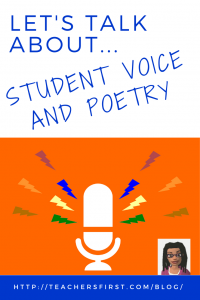 Today is World Voice Day, and the theme this year is “Focus on Your Voice”. While the organizers are more concerned with the science behind vocal communication, there is an opportunity here to encourage student voice. As educators, we can help students learn to contribute their values and perspectives to conversations as we teach and learn together. It is especially important to hear student voices during this current public health crisis.
Today is World Voice Day, and the theme this year is “Focus on Your Voice”. While the organizers are more concerned with the science behind vocal communication, there is an opportunity here to encourage student voice. As educators, we can help students learn to contribute their values and perspectives to conversations as we teach and learn together. It is especially important to hear student voices during this current public health crisis.
What better time to hear student voices than National Poetry Month? This month-long literary celebration reminds us of the role poetry plays in our culture. As our way of life shifts and changes as we deal with a worldwide crisis, poetry will help our global community to express the feelings and concerns of the time.
The American Academy of Poets suggests that we use this time to Shelter in Poems. Find a poem that helps you find the strength and energy to maintain forward momentum as we limit our mobility, or perhaps one that helps you feel connected with others. Going through that exercise and sharing the poem would give both you and your students agency to express what’s happening to the world. Perhaps this is the poem that you keep in your pocket on April 30th.
Your students may not be able to find a poem that adequately shares their voice. Help them share their perspective by writing poetry. Here are a few lesson ideas that would work well in the remote or standard classroom:
- If your students are just starting to write poetry, scaffold their creative process. Use the videos of authors reading their own poetry at No Water River (reviewed here) to inspire your students. Allow them to use the Poem Generator (reviewed here) to write their first few poems.
- Invite students to connect as a class by participating in a Poetic Devices Scavenger Hunt (reviewed here). Use Padlet (reviewed here) or Siftr (reviewed here) to allow students to see one another’s submissions.
- Help students understand how the new poetry inspired by current events will leave a lasting impression for generations to come. Use Poetry and Music of the War Between the States (reviewed here) as examples. Then host a Social Distancing Poetry Slam for your class using Flipgrid (reviewed here).
- Encourage students to create videos that pair imagery with the poem they have chosen. Students can use Adobe Spark (reviewed here) or Animoto (reviewed here). In a post earlier this year, Darshell Silva reminded us to make sure that students understand the need to provide attribution for their poems and the images. Use tools in this collection to find copyright-friendly images for school projects.
What poem will you share to help your students feel connected? How will you use poetry to encourage student voice this month? Leave a note in the comments to share your idea.
Additional Resources:

